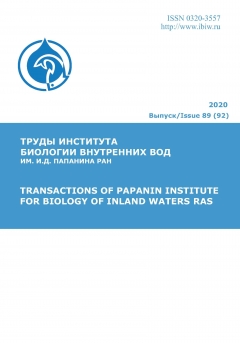UDC 574.64
The history of creation, transformation, scientific staff, heads of the laboratory of Physiology and toxicology of aquatic animals from its formation to the present is presented. The most important results, the main scientific achievements and promising areas of research development are highlighted. The most significant publications of the laboratory staff over a 50-year period are presented.
physiology, toxicology, aquatic animals, laboratory, scientific achievements, history of creation
1. Izyumova N.A. Parazitofauna ryb vodohranilisch SSSR i puti ee formirovaniya. L.: Nauka, 1977. 284 s.
2. Izyumova N.A. Parazity presnovodnyh ryb. Znanie, 1978. 64 s.
3. Volga i ee zhizn'. Moskva: Nauka, 1978. 348 s.
4. Flerov B.A. Ekologo-fiziologicheskie aspekty toksikologii presnovodnyh zhivotnyh. 1989. L., Nauka. 144 s.
5. Vliyanie stokov Cherepoveckogo promyshlennogo uzla na ekologicheskoe sostoyanie Rybinskogo vodohranilischa. Rybinsk, 1990. 156 s.
6. Ekologicheskie problemy Verhney Volgi: Kollektivnaya monografiya. Yaroslavl': Izd-vo YaGTU, 2001. 427 s.
7. Vremennoe metodicheskoe rukovodstvo po normirovaniyu urovney soderzhaniya himicheskih veschestv v DO poverhnostnyh vodnyh ob'ektov (na primere nefti). REFIA NIA-Priroda, M., 2002.
8. Aktual'nye problemy vodnoy toksikologii. Rybinsk: “Rybinskiy dom pechati”, 2004. 248 s.
9. Ekosistema maloy reki v izmenyayuschihsya usloviyah sredy. M.: T-vo nauchn. izdaniy KMK. 2007. 372 s.
10. Komov V.T. Prichiny i posledstviya antropogennogo zakisleniya ozer. Kurs lekciy. Nizhniy Novgorod: Vektor-Tis, 2007. 112 s.
11. Chalova I.V., Krylov A.V. Ocenka kachestva prirodnyh i stochnyh vod metodami biotestirovaniya s ispol'zovaniem vetvistousyh rakobraznyh (Cladocera, Crustacea). Nauchno-metodicheskoe izdanie. Rybinsk: “Rybinskiy dom pechati”, 2007. 51 s.
12. Sostoyanie ekosistemy ozera Nero v nachale XXI veka. M.: Nauka, 2008. 406 s.
13. Vodnye ekosistemy basseyna Selengi. Trudy sovmestnoy rossiysko-mongol'skoy kompleksnoy biologicheskoy ekspedicii. M., 2009. 406 s.
14. Ekologiya ozera Sevan v period povysheniya ego urovnya. Mahachkala: Nauka DNC, 2010. 348 s.
15. Ekologiya vnutrennih vod V'etnama. M.: T-vo nauchn. izdaniy KMK. 2014. 435 s.
16. Ekologicheskiy monitoring. Chast' VIII. Sovremennye problemy monitoringa presnovodnyh ekosistem: Uchebnoe posobie. Nizhniy Novgorod: Nizhegorodskiy gosuniversitet, 2014. 374 s.
17. Struktura i funkcionirovanie ekosistemy Rybinskogo vodohranilischa v nachale XXI veka M.: RAN, 2018. 456 s.
18. Chuyko G.M., Tomilina I.I., Holmogorova N.V. Kompleksnaya ocenka bioekologicheskih i himicheskih sistem. Uchebnoe posobie. Yaroslavl': YarGU, 2018. 140 s.
19. Ekologicheskiy monitoring. Chast' X. Uchebnoe posobie. Nizhniy Novgorod: Nizhegorodskiy gosuniversitet, 2019. 188 s.
20. Rivers of Europe. Tockner K., Zarfl C., Robinson C.T. (Eds.) Ch. 2 The Volga River. Mineeva N., Lazareva V., Litvinov A., Stepanova I., Chuiko G. et al. P. 27–79. 2022, Elsevier.
21. Flerov B.A. Ob ispol'zovanii v vodnoy toksikologii issledovaniy povedeniya zhivotnyh // Gidrobiologicheskiy zhurnal. 1974. T. 10. № 5. S. 114.
22. Gdovskiy P.A., Flerov B.A. Fiziologo-biohimicheskie mehanizmy deystviya hlororganicheskih soedineniy u vodnyh zhivotnyh // Gidrobiologicheskiy zhurnal. 1979. T. 15. № 6. S. 76–85.
23. Ruzhinskaya N.N., Gdovskiy P.A. Osobennosti lokalizacii i vozmozhnaya rol' acetilholinesterazy v obonyatel'noy lukovice ryb // Sensornye sistemy. 1992. T. 6. № 3. S. 26.
24. Matey V.E., Pavlov D.F., Chuyko G.M. Vliyanie kadmiya na strukturu zhabr tilyapii // Citologiya. 1993. T. 35. № 10. S. 1–18.
25. Kozlovskaya V.I., Mayer F.L., Menzikova O.V., Chuyko G.M. Cholinesterases of aquatic animals // Rev. Environ. Contam. Toxicol. 1993. Vol. 132. P. 117–142.
26. Kuz'mina V.V., Chuiko G.M., Pavlov D.F. Effects of DDVP, naphthalene and cadmium , on intestinal proteolytic activity in mozambique tilapia (Oreochromis mossambicus Peters) // Bulletin of Environmental Contamination and Toxicology. 1999. T. 62. № 2. S. 193–198.
27. Chuiko G.M., Podgornaya V.A. Acetylcholinesterase and butyrylcholinesterase of freshwater teleosts // Chemico-Biological Interactions. 2005. Vol. 157–158. P. 365–366.
28. Gdovskiy P.A., Ruzhinskaya N.N Acetilholinesteraza — biomarker funkcional'nogo sostoyaniya obonyatel'noy sistemy ryb // Uspehi sovremennoy biologii. 2007. T. 127. № 4. S. 396–404.
29. Chuiko G.M., Flerov B.A., Stepanova V.M., Zhelnin Y.Y., Podgornaya V.A., Tillitt D.E., Zajicek J.L. Chemical contamination of the HEMICAL CONTAMINATION OF THE Rybinsk reservoir, Northwest Russia: relationship between liver polychlorinated biphenyls (PCB) content and health indicators in bream (Abramis brama) // Chemosphere. 2007. T. 67. № 3. S. 527–536.
30. Kamshilova T.B., Mikryakov V.R., Mikryakov D.V. Vliyanie analoga kortizola na chastotu vstrechaemosti mikroyader v eritorocitah perifericheskoy krovi sterlyadi Acipenser ruthenus // Biologiya vnutrennih vod. 2013. № 2. S. 94.
31. Pavlov D.F., Bezuidenhout Ja., Frontasyeva M.V., Goryainova Z.I. Differences in trace element content between non-indigenous farmed and invasive bivalve mollusks of the South African coast // American Journal of Analytical Chemistry. 2015. T. 6. № 11. S. 886–897.
32. Krylov A.V., Chalova I.V., Lapeeva N.S., Tselmovich O.L., Romanenko A.V., Lavrov V.L. Experimental studies of the effect of beaver (Castor fiber L.) vital activity products on the formation of zooplankton structure (by the example of growth of two cladoceran spesies of different sizes) // Contemporary Problems of Ecology. 2016. T. 9. № 4. S. 494–502.
33. Kholodkevich S.V., SharovA.N., Chuiko G.M., Kuznetsova T.V., Gapeeva M.V., Lozhkina R.A. Quality Assessment of Freshwater Ecosystems by the Functional State of Bivalved Mollusks // Water Resources, 2019, Vol. 46, № 2. P. 249–257.
34. Shevchenko N., Chalova I. The first data on the study of the influence of waste products of semiaquatic birdson planktonic crustaceans and fish (laboratory experiments) // Ecosystem Transformation. 2019. T. 2. № 3 (5). P. 47–51.
35. Lozhkina R.A., Shobanov N.A., Bolshakov V.V., Antipov I.A. Specific features of the cytogenetic structure of the population of Chironomus plumosus (L.) (Diptera, Chironomidae) in a small creek (Udmurt Republic, Russia) // Inland Water Biology. 2019. Vol. 12. P. 119–122.
36. Shevchenko N.S., Chalova I.V., Cel'movich O.L., Zhgareva N.N., Krylov A.V., Elizarov M.E. Eksperimental'noe izuchenie vliyaniya vremeni nahozhdeniya na sushe ekskrementov okolovodnyh ptic na chislennost' Copepoda i plodovitost' Cladocera // Biologiya vnutrennih vod. 2019. № 3. S. 100–103.
37. Klimova Ya.S., Chuiko G.M., Pesnya D.S., Ivanova E.S. Biomarkers of Oxidative Stress in Freshwater Bivalve Mollusks (Review) // Inland Water Biology, 2020, Vol. 13, № 4. P. 681–690.
38. Chuiko G.M., Tomilina I.I., Pavlov D.F., et al. Accumulation of polychlorinated biphenyls (PCB) associated with bottom sediments in larvae of Chironomus riparius Meigen // Limnologica — Ecology and Management of Inland Waters. 2021. T. 90. P. 125912.
39. Kopylov A.I., Zabotkina E.A. Virioplankton as an important component of plankton in the Volga reservoirs // Biosystems diversity. 2021. Vol. 29. № 2. P. 151–159.
40. Udodenko Y.G., Komov V.T., Ivanova E.S., Robinson C.T., Choijil J., Badrakh R., Munkhbat J. Mercury levels in sediment, fish and macroinvertebrates of the Boroo River, Northern Mongolia, under the legacy of gold mining // Ecotoxicology. 2022. T. 31. № 2. S. 312–323.
41. Komov V.T., Gremyachikh V.A. Variation in mercury concentrations in the muscles of fish in biotopes within the water body and in different water bodies of Russia // Limnology and Freshwater Biology. 2022. № 3. P. 1280–1282.
42. Morozov A.A., Berezina N.A., Sladkova S.V., Chernova E.N., Yurchenko V.V. Biochemical and respiratory parameters in a gastropod Radix balthica exposed to diclofenac. Comparative Biochemistry and Physiology C-Toxicology & Pharmacology. 2022. Vol. 252. 109240.
43. Yurchenko V., Morozov A. Responses of hepatic biotransformation and antioxidant enzymes in Japanese medaka (Oryzias latipes) exposed to humic acid. Fish Physiology and Biochemistry. 2022. Vol. 48. Is. 1. P. 1–13.
44. Komov V.T., Gremyachikh V.A. Variations in mercury concentrations in the muscles of fish in biotopes within the water body and in different water bodies of Russia // Limnology and Freshwater Biology. 2022. № 3. S. 1280–1282.
45. Ivanova E., Eltsova L., Komov V., Udodenko Y. et al. Assessment of the consumptive safety of mercury in fish from the surface waters of the Vologda region in northwestern Russia // Environ Geochem Health. 2023. Vol. 45(3). P. 863–879. DOI:https://doi.org/10.1007/s10653-022-01254-4.
46. Flerova E., Yurchenko V., Morozov A., et al. Histology and Ultrastructure of the Nephron and Kidney Interstitial Cells in the Atlantic Salmon (Salmo salar Linnaeus 1758) at Different Stages of Life Cycle // Biology (Basel). 2023. Vol. 19. P. 750. DOI:https://doi.org/10.3390/biology12050750.
47. Tyutin A.V., Medyantseva E.N., Tyutin V.A., Pavlov D.F., Makrushin A.V. Communities of trematodes in ponto-azov gravel snail Lithoglyphus naticoides (C. Pfeiffer, 1828) Gastropoda: Hydrobiidae) and their potential impact on the development of marginal host populations the Volga river basin // Invertebrate Zoology. 2023. T. 20. № 2. P. 205–222.
48. Lozhkina R.A., Seleznev D.G., Tomilina I.I., Gapeeva M.V. Multivariate statistical analysis in assessing surface water toxicity in the Volga reservoirs (based on the results of bioassay and chemical analysis) // Water Resources. 2023. T. 50. № 2. P. 203–212.
49. Trofimov D.Yu., Zabotkina E.A. Effect of trypanosome infection on hematological parameters of the Black Sea sprat (Clupeonella cultriventris) from the Ivankovo reservoir // Inland Water Biology. 2024. T. 17. № 2. P. 370–373.








